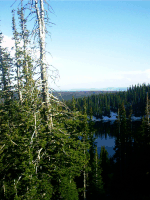
2007-06-23 19.26.18 — 0.3 MB — map
|
Summer in the Rocky Mountains dissolves winter's snowpack with warm rains. All along the Continental Divide, meltwater rises in brooks and runs toward the sea. Some heads west to the Pacific. Some heads north to Hudson Bay.
|
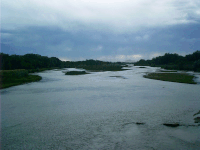
2007-06-16 16.51.26 — 0.4 MB — map
|
Other waters wend eastward, flowing into the great inland rivers of North America that drain toward the Gulf of Mexico. Among these is the Platte, a tributary of the Missouri River below Omaha, NE.
The name means "flat" in French just as the name Nebraska means "flat" in Otoe.
|
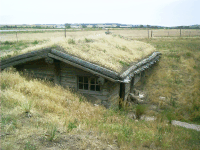
2007-06-26 12.08.28 — 0.6 MB — map
|
Before there were roads and telegraphs and railroads, the creeks and rivers and the trails up them and between them were highways. Trading posts were established here and there along streams. This is a reconstruction of one on Bordeaux Creek at Chadron, NE.
The Platte and its tributaries provided a more or less broad, flat, well watered route up into the Rocky Mountains.
Traders bartered manufactured goods with the Indians in exchange for food and animal skins. The endeavor must have been profitable. It wasn't long before trappers from all over the world converged on the mountains of the American West.
|
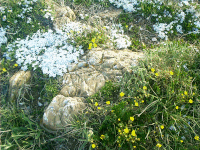
2007-06-23 19.47.34 — 0.9 MB — map
|
Furs were taken in the fall and spring and dried and baled for delivery to market.
|
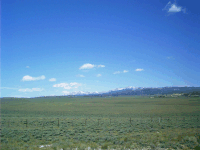
2007-06-18 13.11.00 — 0.4 MB — map
|
Fur companies did not allow their employees to roam the continent, though. Instead, they collected a year's worth of pelts during a summer "rendezvous" in the mountains. At the same time they distributed supplies for the next year. Independent trappers from the States, Canada, Mexico, and abroad as well as Native Americans were welcome because they had pelts to sell and they were buyers of supplies.
The first ten wagons ever to follow the flat route along the Platte River to the Rocky Mountains were in a supply train from St. Louis, MO, led by William Sublette to the Wind River rendezvous of 1830.
|
A well known letter is dated St. Louis, MO, October 29, 1830, and is addressed to the Hon. J. H. Eaton, Secretary of War: "The business of taking furs from the United States Territories beyond the Rocky Mountains has since been continued by Jedediah S. Smith, David E. Jackson and W. L. Sublette, under the firm name of Smith, Sublette and Jackson.
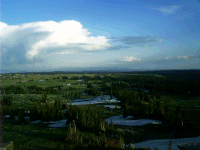
2007-06-23 19.46.14 — 0.4 MB — map
|
Of course, there was one market for furs in the mountains, another in St. Louis, MO, and yet another in London, England. Liquor and other goods bartered at the rendezvous commanded the highest rate of exchange relative to pelts. Few trappers got very far ahead, dealing with the "company store." The handful that became famous were good at keeping accounts and better at bargaining and rose to management rank in their respective outfits.
The fur trade had the effect, intentional or inadvertent, of making the Indian nations gradually more dependent on manufactured goods. This led to all sorts of political intrigue among the tribes and between them and the United States.
|
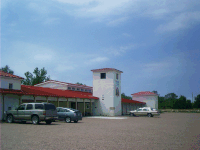
2007-06-26 12.46.08 — 0.4 MB — map
|
The Museum of the Fur Trade opened to the public in Chadron, NE, in 1955.
It may be out of the way, but its exhibits are world class, including artifacts from as long ago as the 17th century as well as products still in commerce up to the present day. Displays include articles collected from every continent. The museum is a respected resource for prop and costume design for the movie industry. In their lists of references, reenactors give the Museum of the Fur Trade more than alphabetic precedence over the National Park Service's Museum of Westward Expansion in St. Louis, MO.
"The trade goods collection consists not of the things that Indians made, but of the things Indians used to make things. Native people purchased the prosaic and the exotic, the utilitarian and the superfluous. Traders provided the weapons to hunt and make war, the paint used to decorate the face, and everything in-between. And all these are represented in the Museum of the Fur Trade.
|
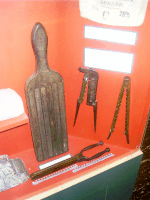
2007-06-26 11.55.22 — 0.2 MB — map
|
"A special part of the museum's collection is firearms made exclusively for sale to Indians. It includes the earliest known intact trade gun, made in the Netherlands before 1650. The personal firearms of such famous Americans as John Kinzie, Kit Carson, Tecumseh, and Young Man Afraid of His Horses are on public exhibition. Over 200 Northwest guns manufactured between 1751 and 1900 in England, Belgium, and the United States are on exhibit. It is the largest and most comprehensive collection of these firearms in existence."
|
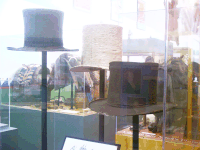
2007-06-26 11.15.40 — 0.3 MB — map
|
In the 18th and early 19th century the mercantile economies of Europe and America became determined to extract as much raw material from their frontiers as they could as quickly as possible. Dried beaver pelts were a commodity in demand. For these, government-chartered traders and renegades exchanged an array of cheaply manufactured items as the following slides will show.
What became of the furs? They were shipped to Europe to be made into felt hats.
|
In the Green River basin, the fur trade flickered to life in the early 1820s, blazed for 15 years, and abruptly burned out.
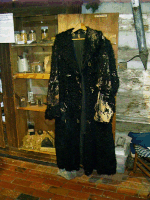
2007-06-15 12.53.38 — 0.3 MB — map
|
The Mountain Man's way of life in the Green River basin came to an end when the beaver were trapped out, but one must not leap to the conclusion that that was the end of the fur trade in North America. Bison robes were traded on the Great Plains up to the beginning of the Civil War, and a market for buffalo hides continued afterward until the freely ranging bison herds were wiped out.
Though the European demand for beaver was diminished, it was not extinguished. Canada continued to export beaver pelts.
• Eddins, Orland Ned. "Mountain Man Rendezvous Sites." Mountain Men Plains Indian Fur Trade History. 3 July 2007 <http://www.mountainsofstone.com/rendezvous_sites.htm>.
There is still a market for beaver. In fact, you can buy, today, a good contemporary cowboy-style felt hat that, the manufacturer will promise, contains (an undisclosed proportion of) beaver fur.
|
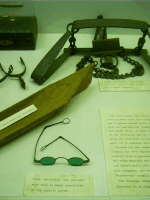
2007-06-26 11.26.58 — 0.2 MB — map
|
For awhile, though, the future of the fur trade was so bright the trappers had to wear shades.
|
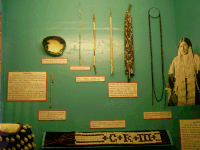
2007-06-26 12.23.34 — 0.5 MB — map
|
Some items manufactured for trade duplicated those produced by indigenous craft. Wampum could be machined more cheaply than it could be made by hand.
"Wampum is a term for cylindrical beads cut from the quahog clamshell. The Indians around Long Island made them in prehistoric times, and Dutch fur traders adopted their use as a medium of exchange among the tribes of eastern North America."
• Display note. Museum of the Fur Trade, Chadron, NE. 26 June 2007.
|
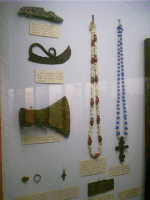
2007-06-26 10.49.06 — 0.2 MB — map
|
Beads as articles of adornment are known in all cultures, so it won't do to think of them as circumpolar and spreading from Northern Europe. It is true, however, that most trade beads were manufactured in Eastern Europe (as they are today). The technology is a holdover from the Viking era.
|
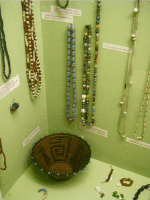
2007-06-26 12.16.56 — 0.2 MB — map
|
|
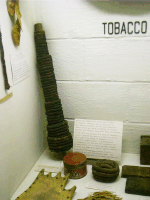
2007-06-26 12.25.58 — 0.2 MB — map
|
Intensive tobacco culture in the States developed out of practices barely distinguishable from indigenous methods. Plains Indians, of course, were net importers of tobacco.
"Nearly all Indian tribes grew some variety of tobacco. However, none of them seem to have been as desirable as the South American tobacco which was being cultivated in Colonial Maryland and Virginia soon after white settlement.
"To the left is a portion of a roll of 'pigtail' tobacco, twisted and spun on a wheel by slaves and shipped from Brazil or Virginia to the wilderness trading posts.
|
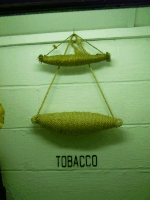
2007-06-26 12.25.50 — 0.2 MB — map
|
"A second method of packing in the 18th and 19th centuries was to make leaves into a compact package wrapped in linen and wound with cord to make a 'carrot.'
"Above is an old one-pound carrot found in exhibition in a New York tobacco shop. The [… three] pound size is of modern manufacture."
• Display note. Museum of the Fur Trade, Chadron, NE. 26 June 2007.
|
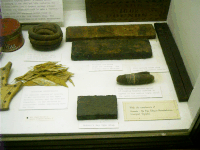
2007-06-26 12.26.52 — 0.4 MB — map
|
|
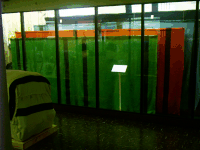
2007-06-26 11.50.24 — 0.4 MB — map
|
"Legend has it that British tax collectors levied export duty on each blanket, so blanket makers finished them in pairs. They were always supplied in pairs in the fur trade and then cut in two for the customer."
• "Pairs." Display note. Museum of the Fur Trade, Chadron, NE. 26 June 2007.
|
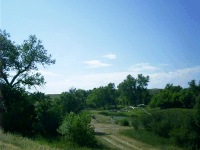
2007-06-17 09.59.10 — 0.4 MB — map
|
The mountain men bequeathed their names to landmarks throughout the West.
Nothing whatever is known about Jacques LaRamée who disappeared in the northern reaches of the front range of the Rockies about 1820. Since then, however, that part of the mountains and the river that flows through it have been called after him.
|
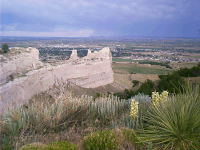
2007-06-16 18.36.22 — 0.6 MB — map
|
In 1828, a clerk for the American Fur Company named Hiram Scott fell ill. His colleagues abandoned him to his death on the banks of the North Platte. The next year agents of the company discovered enough of his remains to identify the corpse and necessitate a funeral. The prominent bluffs 60 miles downstream from the mouth of the Laramie River have been called Scotts Bluff ever since, and travelers have thrilled to every retelling of his story.
"The Hiram Scott legend is mentioned by almost all early travelers who have left record of a journey up the North Platte Valley, but it would be fruitless to recite the many other varied, conflicting, and often quaint versions of how he died. There are differences of opinion as to the distance the poor fellow crawled, if any; whether the party traveled on foot or by horseback, muleback, bullboat, raft, or canoe; whether he was a victim of Indians, exposure, drowning, freezing, disease, or starvation; the location of his skeleton; the identity and number of his companions; whether their desertion was premeditated; whether it was justified; how their treachery was exposed; and, finally, whether the whole thing might not have been a grisly hoax!
|
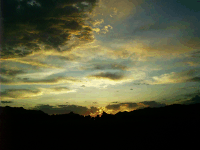
2007-06-16 20.29.44 — 0.3 MB — map
|
"It was not a hoax. Though the legend has become hopelessly confused, research has proved that there was a Hiram Scott prominent in the Rocky Mountain fur trade from 1823 until 1827; and that he disappeared in 1828 and was never heard from thereafter, except through the faint echoes of the legend. His companions remain unidentified, but research strongly suggests that William Sublette was the leader of the 1828 caravan, who issued instructions to these men to remain with him; and it was William Sublette who led the springtime caravan of 1829 that discovered Scott's skeleton, miles away from the spot where they reported he had died."
• Mattes, Merrill J. Scotts Bluff National Monument Nebraska. 1958. Historical Handbook 28. Washington, DC: National Park Service, 9 Dec. 2000. 27 July 2007 <http://www.nps.gov/history/history/online_books/hh/28/index.htm>.
|




















